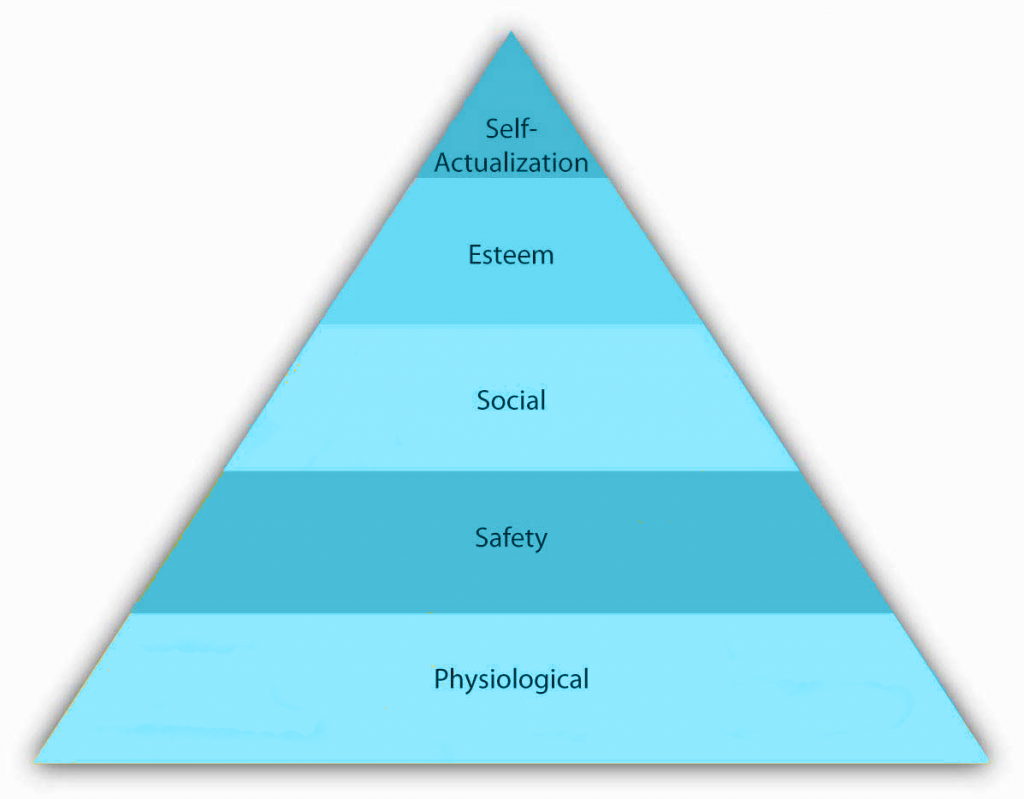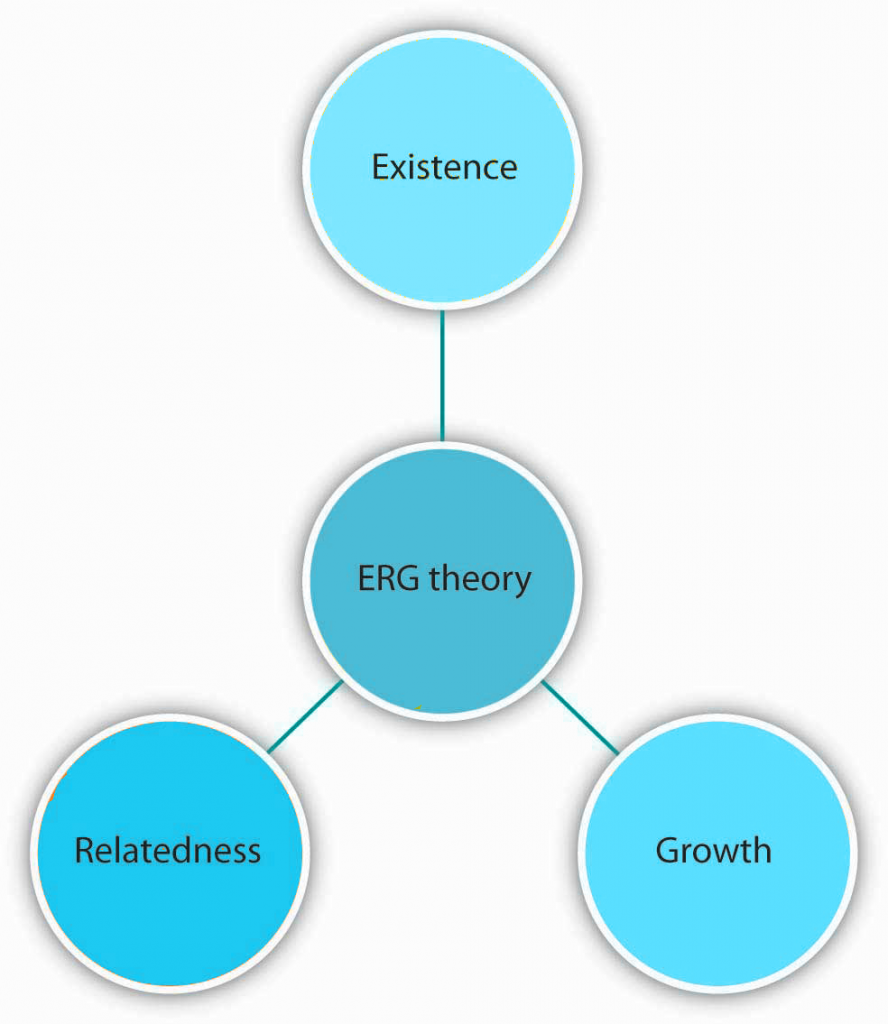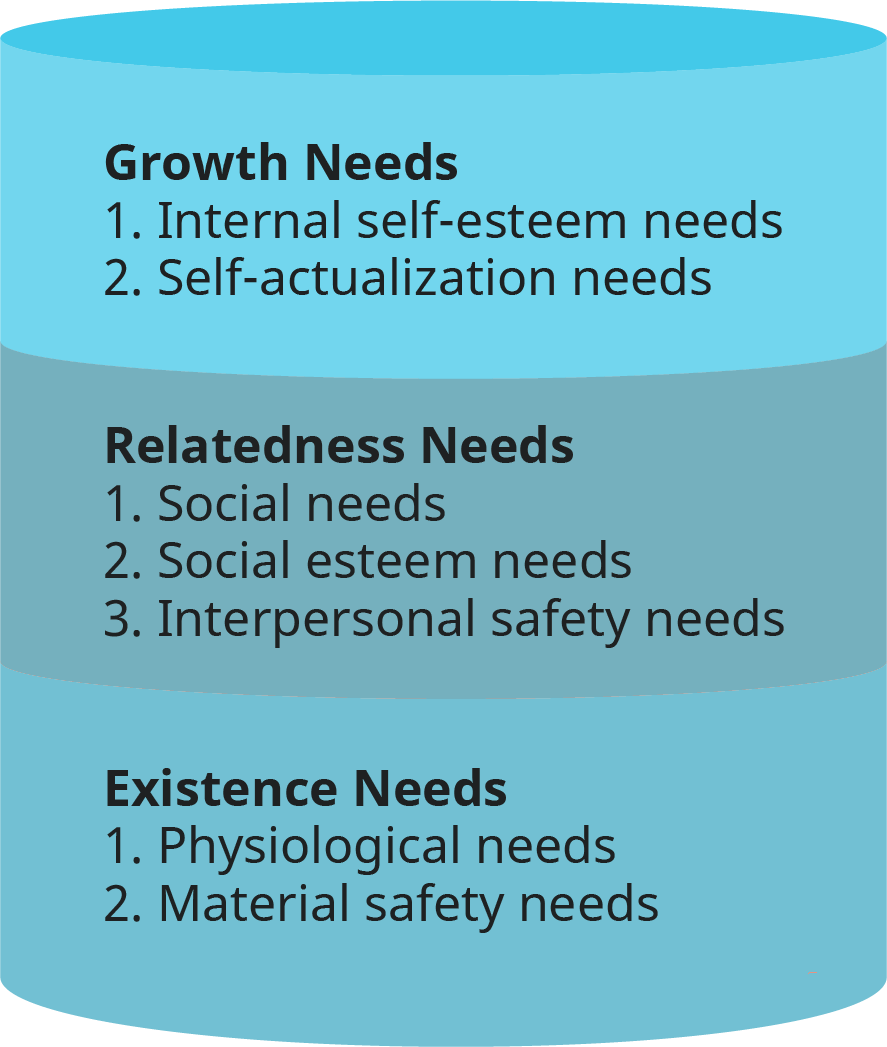4.2 Need-Based Theories of Motivation
The earliest studies of motivation involved an examination of individual needs. Specifically, early researchers thought that employees try hard and demonstrate goal-driven behaviour in order to satisfy needs. For example, an employee who is always walking around the office talking to people may have a need for companionship, and his behaviour may be a way of satisfying this need. At the time, researchers developed theories to understand what people need. Four theories may be placed under this category: Maslow’s hierarchy of needs, ERG theory, Herzberg’s two-factor theory, and McClelland’s acquired-needs theory.
In this section:
Maslow’s Hierarchy of Needs
Abraham Maslow is among the most prominent psychologists of the twentieth century. His hierarchy of needs is an image familiar to most business students and managers. The theory is based on a simple premise: Human beings have needs that are hierarchically ranked (Maslow, 1943; Maslow, 1954). There are some needs that are basic to all human beings, and in their absence, nothing else matters. As we satisfy these basic needs, we start looking to satisfy higher-order needs. In other words, once a lower-level need is satisfied, it no longer serves as a motivator.

The most basic of Maslow’s needs are physiological needs. Physiological needs refer to the need for food, water, and other biological needs. These needs are basic because when they are lacking, the search for them may overpower all other urges. Imagine being very hungry. At that point, all your behaviour may be directed at finding food. Once you eat, though, the search for food ceases, and the promise of food no longer serves as a motivator. Once physiological needs are satisfied, people tend to become concerned about safety needs. Are they free from the threat of danger, pain, or an uncertain future? On the next level up, social needs refer to the need to bond with other human beings, be loved, and form lasting attachments with others. In fact, attachments, or lack of them, are associated with our health and well-being (Baumeister & Leary, 1995). The satisfaction of social needs makes esteem needs more salient. Esteem need refers to the desire to be respected by one’s peers, feel important, and be appreciated. Finally, at the highest level of the hierarchy, the need for self-actualization refers to “becoming all you are capable of becoming.” This need manifests itself by the desire to acquire new skills, take on new challenges, and behave in a way that will lead to the attainment of one’s life goals.
Maslow was a clinical psychologist, and his theory was not originally designed for work settings. In fact, his theory was based on his observations of individuals in clinical settings; some of the individual components of the theory found little empirical support. One criticism relates to the order in which the needs are ranked. It is possible to imagine that individuals who go hungry and are in fear of their lives might retain strong bonds to others, suggesting a different order of needs. Moreover, researchers failed to support the arguments that once a need is satisfied it no longer serves as a motivator and that only one need is dominant at a given time (Neher, 1991; Rauschenberger et al., 1980).
Despite the lack of strong research support, Maslow’s theory found obvious applications in business settings. Understanding what people need gives us clues to understanding them. The hierarchy is a systematic way of thinking about the different needs employees may have at any given point, and explains different reactions they may have to similar treatment. An employee who is trying to satisfy esteem needs may feel gratified when her supervisor praises an accomplishment. However, another employee who is trying to satisfy social needs may resent being praised by upper management in front of peers if the praise sets the individual apart from the rest of the group.
How can an organization satisfy its employees’ various needs? In the long run, physiological needs may be satisfied by the person’s paycheck, but it is important to remember that pay may satisfy other needs such as safety and esteem as well. Providing generous benefits that include health insurance and company-sponsored retirement plans, as well as offering a measure of job security, will help satisfy safety needs. Social needs may be satisfied by having a friendly environment and providing a workplace conducive to collaboration and communication with others. Company picnics and other social get-togethers may also be helpful if the majority of employees are motivated primarily by social needs (but may cause resentment if they are not and if they have to sacrifice a Sunday afternoon for a company picnic). Providing promotion opportunities at work, recognizing a person’s accomplishments verbally or through more formal reward systems, and conferring job titles that communicate to the employee that one has achieved high status within the organization are among the ways of satisfying esteem needs. Finally, self-actualization needs may be satisfied by the provision of development and growth opportunities on or off the job, as well as by work that is interesting and challenging. By making the effort to satisfy the different needs of each employee, organizations may ensure a highly motivated workforce.
ERG Theory

ERG theory, developed by Clayton Alderfer, is a modification of Maslow’s hierarchy of needs (Alderfer, 1969). Instead of the five needs that are hierarchically organized, Alderfer proposed that basic human needs may be grouped under three categories, namely, existence, relatedness, and growth. Existence corresponds to Maslow’s physiological and safety needs, relatedness corresponds to social needs, and growth refers to Maslow’s esteem and self-actualization.
- Existence needs include physiological and material safety needs. These needs are satisfied by material conditions and not through interpersonal relations or personal involvement in the work setting.
- Relatedness needs include all of Maslow’s social needs, plus social safety and social esteem needs. These needs are satisfied through the exchange of thoughts and feelings with other people.
- Growth needs include self-esteem and self-actualization needs. These needs tend to be satisfied through one’s full involvement in work and the work setting.
Figure 4.4 below identifies a number of ways in which organizations can help their members satisfy these three needs:

Image Description
Figure 4.4 is a three-tiered cylindrical diagram illustrating ERG theory. The top, light-blue band is labelled Growth Needs with two bullets: “1. Internal self-esteem needs” and “2. Self-actualization needs.” The middle band is labelled Relatedness Needs with three bullets: “1. Social needs,” “2. Social esteem needs,” and “3. Interpersonal safety needs.” The bottom band is labelled Existence Needs with two bullets: “1. Physiological needs” and “2. Material safety needs.”
Four components—satisfaction progression, frustration, frustration regression, and aspiration—are key to understanding Alderfer’s ERG theory. The first of these, satisfaction progression, is in basic agreement with Maslow’s process of moving through the needs. As we increasingly satisfy our existence needs, we direct energy toward relatedness needs. As these needs are satisfied, our growth needs become more active. The second component, frustration, occurs when we attempt but fail to satisfy a particular need. The resulting frustration may make satisfying the unmet need even more important to us—unless we repeatedly fail to satisfy that need. In this case, Alderfer’s third component, frustration regression, can cause us to shift our attention to a previously satisfied, more concrete, and verifiable need. Lastly, the aspiration component of the ERG model notes that, by its very nature, growth is intrinsically satisfying. The more we grow, the more we want to grow. Therefore, the more we satisfy our growth need, the more important it becomes and the more strongly we are motivated to satisfy it.
ERG theory’s main contribution to the literature is its relaxation of Maslow’s assumptions. ERG theory does not rank needs in any particular order and explicitly recognizes that more than one need may operate at a given time. For example, it is difficult for researchers to ascertain when interaction with others satisfies our need for acceptance and when it satisfies our need for recognition. ERG also focuses attention explicitly on movement through the set of needs in both directions. Further, evidence in support of the three need categories and their order tends to be stronger than evidence for Maslow’s five need categories and their relative order. Moreover, the theory discusses frustration, whereas Maslow’s theory does not. For example, someone who is frustrated by the growth opportunities in his job and progress toward career goals may regress to a relatedness need and start spending more time socializing with coworkers. The implication of this theory is that we need to recognize the multiple needs that may be driving individuals at a given point to understand their behaviour and properly motivate them.
Two-factor Theory
Frederick Herzberg approached the question of motivation in a different way. By asking individuals what satisfies them on the job and what dissatisfies them, Herzberg came to the conclusion that aspects of the work environment that satisfy employees are very different from aspects that dissatisfy them (Herzberg et al., 1959; Herzberg, 1965). Herzberg labelled factors causing dissatisfaction of workers as “hygiene” factors because these factors were part of the context in which the job was performed, as opposed to the job itself. Hygiene factors included company policies, supervision, working conditions, salary, safety, and security on the job. To illustrate, imagine that you are working in an unpleasant work environment. Your office is too hot in the summer and too cold in the winter. You are being harassed and mistreated. You would certainly be miserable in such a work environment. However, if these problems were solved (your office temperature is just right and you are not harassed at all), would you be motivated? Most likely, you would take the situation for granted. In fact, many factors in our work environment are things that we miss when they are absent but take for granted if they are present.
In contrast, motivators are factors that are intrinsic to the job, such as achievement, recognition, interesting work, increased responsibilities, advancement, and growth opportunities. According to Herzberg’s research, motivators are the conditions that truly encourage employees to try harder.
Table 4.1: The Two-factor Theory
| Hygiene Factors | Motivators |
|---|---|
| Company policy | Achievement |
| Supervision and relationships | Recognition |
| Working conditions | Interesting work |
| Salary | Increased responsibility |
| Security | Advancement and growth |
The two-factor theory of motivation includes hygiene factors and motivators. Based on Herzberg, F., Mausner, B., & Snyderman, B. (1959).
Herzberg’s research is far from being universally accepted (Cummings & Elsalmi, 1968; House & Wigdor, 1967). One criticism relates to the primary research methodology employed when arriving at hygiene versus motivators. When people are asked why they are satisfied, they may attribute the causes of satisfaction to themselves, whereas when explaining what dissatisfies them, they may blame the situation. The classification of the factors as hygiene or motivator is not that simple either. For example, the theory views pay as a hygiene factor. However, pay may have symbolic value by showing employees that they are being recognized for their contributions as well as communicating that they are advancing within the company. Similarly, the quality of supervision or the types of relationships employees form with their supervisors may determine whether they are assigned interesting work, whether they are recognized for their potential, and whether they take on more responsibilities.
Despite its limitations, the theory can be a valuable aid to managers because it points out that improving the environment in which the job is performed goes only so far in motivating employees. Undoubtedly, contextual factors matter because their absence causes dissatisfaction. However, solely focusing on hygiene factors will not be enough, and managers should also enrich jobs by giving employees opportunities for challenging work, greater responsibilities, advancement opportunities, and a job in which their subordinates can feel successful.
Acquired Needs Theory
Among the need-based approaches to motivation, David McClelland’s acquired-needs theory is the one that has received the greatest amount of support. According to this theory, individuals acquire three types of needs as a result of their life experiences. These needs are the need for achievement, the need for affiliation, and the need for power. All individuals possess a combination of these needs, and the dominant needs are thought to drive employee behaviour. McClelland believes that these three needs are learned, primarily in childhood. But he also believes that each need can be taught, especially nAch. McClelland’s research is important because much of the current thinking about organizational behaviour is based on it.
Need for Achievement
The need for achievement (nAch) is how much people are motivated to excel at the tasks they are performing, especially tasks that are difficult. Of the three needs studied by McClelland, nAch has the greatest impact. The need for achievement varies in intensity across individuals. This makes nAch a personality trait as well as a statement about motivation. When nAch is being expressed, making it a manifest need, people try hard to succeed at whatever task they’re doing. We say these people have a high achievement motive. A motive is a source of motivation; it is the need that a person is attempting to satisfy. Achievement needs become manifest when individuals experience certain types of situations.
To better understand the nAch motive, it’s helpful to describe high-nAch people. You probably know a few of them. They’re constantly trying to accomplish something. One of your authors has a father-in-law who would much rather spend his weekends digging holes (for various home projects) than going fishing. Why? Because when he digs a hole, he gets results. In contrast, he can exert a lot of effort and still not catch a fish. A lot of fishing, no fish, and no results equal failure!
McClelland describes three major characteristics of high-nAch people:
- They feel personally responsible for completing whatever tasks they are assigned. They accept credit for success and blame for failure.
- They like situations where the probability of success is moderate. High-nAch people are not motivated by tasks that are too easy or extremely difficult. Instead, they prefer situations where the outcome is uncertain, but in which they believe they can succeed if they exert enough effort. They avoid both simple and impossible situations.
- They have very strong desires for feedback about how well they are doing. They actively seek out performance feedback. It doesn’t matter whether the information implies success or failure. They want to know whether they have achieved or not. They constantly ask how they are doing, sometimes to the point of being a nuisance.
Why is nAch important to organizational behaviour? The answer is, the success of many organizations is dependent on the nAch levels of their employees. This is especially true for jobs that require self-motivation and managing others. Employees who continuously have to be told how to do their jobs require an overly large management team, and too many layers of management spell trouble in the current marketplace. Today’s flexible, cost-conscious organizations have no room for top-heavy structures; their high-nAch employees perform their jobs well with minimal supervision.
Many organizations manage the achievement needs of their employees poorly. A common perception about people who perform unskilled jobs is that they are unmotivated and content doing what they are doing. But if they have achievement needs, the job itself creates little motivation to perform. It is too easy. There are not enough workers who feel personal satisfaction in having the cleanest floors in a building. Designing jobs that are neither too challenging nor too boring is key to managing motivation. Job enrichment is one effective strategy; this frequently entails training and rotating employees through different jobs or adding new challenges.

New York Metro workers carrying a sign. The New York City Metropolitan Transit Authority undertook a new approach to how they perform critical inspection and maintenance of subway components that are necessary to provide reliable service. Rather than schedule these inspections during regular hours, they consulted with the maintenance workers, who suggested doing the inspections while sections of the subway were closed to trains for seven consecutive hours. This process was adopted and provided a safer and more efficient way to maintain and clean New York City’s sprawling subway. With no trains running, MTA employees are able to inspect signals, replace rails and crossties, scrape track floors, clean stations, and paint areas that are not reachable during normal train operation. Workers also took the opportunity to clean lighting fixtures, change bulbs, and repair platform edges while performing high-intensity station cleaning.
Need for Affiliation
This need is the second of McClelland’s learned needs. The need for affiliation (nAff) reflects a desire to establish and maintain warm and friendly relationships with other people. As with nAch, nAff varies in intensity across individuals. As you would expect, high-nAff people are very sociable. They’re more likely to go bowling with friends after work than to go home and watch television. Other people have lower affiliation needs. This doesn’t mean that they avoid other people, or that they dislike others. They simply don’t exert as much effort in this area as high-nAff people do.
The nAff has important implications for organizational behaviour. High-nAff people like to be around other people, including other people at work. As a result, they perform better in jobs that require teamwork. Maintaining good relationships with their coworkers is important to them, so they go to great lengths to make the work group succeed because they fear rejection. So, high-nAff employees will be especially motivated to perform well if others depend on them. In contrast, if high-nAff people perform jobs in isolation from other people, they will be less motivated to perform well. Performing well on this job won’t satisfy their need to be around other people.
Effective managers carefully assess the degree to which people have high or low nAff. Employees high in nAff should be placed in jobs that require or allow interactions with other employees. Jobs that are best performed alone are more appropriate for low-nAff employees, who are less likely to be frustrated.
Need for Power
The third of McClelland’s learned needs, the need for power (nPow), is the need to control things, especially other people. It reflects a motivation to influence and be responsible for other people. An employee who is often talkative, gives orders, and argues a lot is motivated by the need for power over others.
Employees with high nPow can be beneficial to organizations. High-nPow people do have effective employee behaviours, but at times they’re disruptive. A high-nPow person may try to convince others to do things that are detrimental to the organization. So, when is this need good, and when is it bad? Again, there are no easy answers. McClelland calls this the “two faces of power.” A personal power seeker endeavours to control others, mostly for the sake of dominating them. They want others to respond to their wishes, whether or not it is good for the organization. They “build empires,” and they protect them.
McClelland’s other power seeker is the social power seeker. A high social power seeker satisfies needs for power by influencing others, like the personal power seeker. They differ in that they feel best when they have influenced a work group to achieve the group’s goals, and not some personal agenda. High social power seekers are concerned with goals that a work group has set for itself, and they are motivated to influence others to achieve the goal. This need is oriented toward fulfilling responsibilities to the employer, not to the self.
McClelland has argued that the high need for social power is the most important motivator for successful managers. Successful managers tend to be high in this type of nPow. High need for achievement can also be important, but it sometimes results in too much concern for personal success and not enough for the employer’s success. The need for affiliation contributes to managerial success only in those situations where the maintenance of warm group relations is as important as getting others to work toward group goals.
The implication of McClelland’s research is that organizations should try to place people with high needs for social power in managerial jobs. It is critical, however, that those managerial jobs allow the employee to satisfy the nPow through social power acquisition. Otherwise, a manager high in nPow may satisfy this need through acquisition of personal power, to the detriment of the organization.
McClelland used a unique method called the Thematic Apperception Test (TAT) to assess the dominant need (Spangler, 1992). This method entails presenting research subjects with an ambiguous picture, asking them to write a story based on it. Take a look at the following picture. Who is this person? What is he doing? Why is he doing it? The story you tell about the men in the picture would then be analyzed by trained experts. The idea is that the stories the photo evokes would reflect how the mind works and what motivates the person.

If the story you come up with contains themes of success, meeting deadlines, or coming up with brilliant ideas, you may be high in need of achievement. Those who have a high need for achievement have a strong need to be successful. As children, they may be praised for their hard work, which forms the foundations of their persistence (Mueller & Dweck, 1998). As adults, they are preoccupied with doing things better than they did in the past. These individuals are constantly striving to improve their performance. They relentlessly focus on goals, particularly stretch goals that are challenging in nature (Campbell, 1982). They are particularly suited to positions such as sales, where there are explicit goals, feedback is immediately available, and their effort often leads to success. In fact, they are more attracted to organizations that are merit-based and reward performance rather than seniority. They also do particularly well as entrepreneurs, scientists, and engineers (Harrell & Stahl, 1981; Trevis & Certo, 2005; Turban & Keon, 1993).
Are individuals who are high in need for achievement effective managers? Because of their success in lower-level jobs where their individual contributions matter the most, those with a high need for achievement are often promoted to higher-level positions (McClelland & Boyatzis, 1982). However, a high need for achievement has significant disadvantages in management positions. Management involves getting work done by motivating others. When a salesperson is promoted to be a sales manager, the job description changes from actively selling to recruiting, motivating, and training salespeople. Those who are high in need for achievement may view managerial activities such as coaching, communicating, and meeting with subordinates as a waste of time and may neglect these aspects of their jobs. Moreover, those high in need for achievement enjoy doing things themselves and may find it difficult to delegate any meaningful authority to their subordinates. These individuals often micromanage, expecting others to approach tasks a particular way, and may become overbearing bosses by expecting everyone to display high levels of dedication (McClelland & Burnham, 1976).
If the story you created in relation to the picture you are analyzing contains elements of making plans to be with friends or family, you may have a high need for affiliation. Individuals who have a high need for affiliation want to be liked and accepted by others. When given a choice, they prefer to interact with others and be with friends (Wong & Csikszentmihalyi, 1991). Their emphasis on harmonious interpersonal relationships may be an advantage in jobs and occupations requiring frequent interpersonal interaction, such as a social worker or a teacher. In managerial positions, a high need for affiliation may again serve as a disadvantage because these individuals tend to be overly concerned about how they are perceived by others. They may find it difficult to perform some aspects of a manager’s job, such as giving employees critical feedback or disciplining poor performers. Thus, the work environment may be characterized by mediocrity and may even lead to high performers leaving the team.
Finally, if your story contains elements of getting work done by influencing other people or desiring to make an impact on the organization, you may have a high need for power. Those with a high need for power want to influence others and control their environment. A need for power may in fact be a destructive element in relationships with colleagues if it takes the form of seeking and using power for one’s own good and prestige. However, when it manifests itself in more altruistic forms, such as changing the way things are done so that the work environment is more positive, or negotiating more resources for one’s department, it tends to lead to positive outcomes. In fact, the need for power is viewed as an important trait for effectiveness in managerial and leadership positions (McClelland & Burnham, 1976; Spangler & House, 1991; Spreier, 2006).
McClelland’s theory of acquired needs has important implications for the motivation of employees. Managers need to understand the dominant needs of their employees to be able to motivate them. While people who have a high need for achievement may respond to goals, those with a high need for power may attempt to gain influence over those they work with, and individuals high in their need for affiliation may be motivated to gain the approval of their peers and supervisors. Finally, those who have a high drive for success may experience difficulties in managerial positions, and making them aware of common pitfalls may increase their effectiveness.
Self-Determination Theory
One major implication of Herzberg’s motivator-hygiene theory is the somewhat counterintuitive idea that managers should focus more on motivators than on hygiene. (After all, doesn’t everyone want to be paid well? Organizations have held this out as a chief motivator for decades!) Why might concentrating on motivators give better results? To answer this question, we must examine types of motivation. Organizational behaviour researchers often classify motivation in terms of what stimulates it. In the case of extrinsic motivation, we endeavour to acquire something that satisfies a lower-order need. Jobs that pay well and that are performed in safe, clean working conditions with adequate supervision and resources directly or indirectly satisfy these lower-order needs. These “outside the person” factors are extrinsic rewards.
Factors “inside” the person that cause people to perform tasks, intrinsic motivation, arise out of performing a task in and of itself, because it is interesting or “fun” to do. The task is enjoyable, so we continue to do it even in the absence of extrinsic rewards. That is, we are motivated by intrinsic rewards, rewards that we more or less give ourselves. Intrinsic rewards satisfy higher-order needs like relatedness and growth in ERG theory. When we sense that we are valuable contributors, are achieving something important, or are getting better at some skill, we like this feeling and strive to maintain it.
Self-determination theory (SDT) seeks to explain not only what causes motivation, but also how extrinsic rewards affect intrinsic motivation. In SDT, extrinsic motivation refers to the performance of an activity in order to attain some valued outcome, while intrinsic motivation refers to performing an activity for the inherent satisfaction of the activity itself. SDT specifies when an activity will be intrinsically motivating and when it will not. Considerable numbers of studies have demonstrated that tasks are intrinsically motivating when they satisfy at least one of three higher-order needs: competence, autonomy, and relatedness. These precepts from SDT are entirely consistent with earlier discussions of theories by McClelland, Maslow, Alderfer, and Herzberg.
SDT takes the concepts of extrinsic rewards and intrinsic motivation further than the other need theories. SDT researchers have consistently found that as the level of extrinsic rewards increases, the amount of intrinsic motivation decreases. That is, SDT posits that extrinsic rewards not only do not provide intrinsic motivation, but they also diminish it. Think of this in terms of hobbies. Some people like to knit, others like to carve wood. They do it because it is intrinsically motivating; the hobby satisfies needs for competence, autonomy, and relatedness. But what happens if these hobbyists start getting paid well for their sweaters and carvings? Over time, the hobby becomes less fun and is done in order to receive extrinsic rewards (money). Extrinsic motivation increases as intrinsic motivation decreases! When extrinsic rewards are present, people do not feel like what they do builds competence, is self-determined, or enhances relationships with others.
SDT theory has interesting implications for the management of organizational behaviour. Some jobs are by their very nature uninteresting and unlikely to be made interesting. Automation has eliminated many such jobs, but they are still numerous. SDT would suggest that the primary way to motivate high performance for such jobs is to make performance contingent on extrinsic rewards. Relatively high pay is necessary to sustain performance on certain low-skill jobs. On the other hand, SDT would suggest that to enhance intrinsic motivation on jobs that are interesting, don’t focus only on increasing extrinsic rewards (like large pay bonuses). Instead, create even more opportunities for employees to satisfy their needs for competence, autonomy, and relatedness. That means giving them opportunities to learn new skills, to perform their jobs without interference, and to develop meaningful relationships with other customers and employees in other departments. Such actions enhance intrinsic rewards.
You may have noticed that content theories are somewhat quiet about what determines the intensity of motivation. For example, some people steal to satisfy their lower-order needs (they have high intensity). But most of us don’t steal. Why is this? Process theories of motivation attempt to explain this aspect of motivation by focusing on the intensity of motivation as well as its direction. According to self-determination theory, skilled workers who are given a chance to hone their skills and the freedom to practice their craft will be intrinsically motivated.
Let’s Review
- Need-based theories describe motivated behaviour as individuals’ efforts to meet their needs. According to this perspective, the manager’s job is to identify what people need and make the work environment a means of satisfying these needs.
- Maslow’s hierarchy describes five categories of basic human needs, including physiological, safety, social, esteem, and self-actualization needs. These needs are hierarchically ranked, and as a lower-level need is satisfied, it no longer serves as a motivator.
- ERG theory is a modification of Maslow’s hierarchy, in which the five needs are collapsed into three categories (existence, relatedness, and growth). The theory recognizes that when employees are frustrated while attempting to satisfy higher-level needs, they may regress.
- The two-factor theory differentiates between factors that make people dissatisfied on the job (hygiene factors) and factors that truly motivate employees (motivators).
- Acquired-needs theory argues that individuals possess stable and dominant motives to achieve, acquire power, or affiliate with others. The type of need that is dominant will drive behaviour.
- Finally, self-determination theory explores how motivation can come from external or internal factors. Each of these theories explains characteristics of a work environment that motivates employees. These theories paved the way to process-based theories that explain the mental calculations employees make to decide how to behave.
 Exercises
Exercises
- Many managers assume that if an employee is not performing well, the reason must be a lack of motivation. Do you think this reasoning is accurate? What is the problem with the assumption?
- Review Maslow’s hierarchy of needs. Do you agree with the particular ranking of employee needs?
- How can an organization satisfy employee needs that are included in Maslow’s hierarchy?
- Which motivation theory have you found to be most useful in explaining why people behave in a certain way? Why?
- Review the hygiene and motivators in the two-factor theory of motivation. Do you agree with the distinction between hygiene factors and motivators? Are there any hygiene factors that you would consider to be motivators?
- A friend of yours demonstrates the traits of achievement motivation: This person is competitive, requires frequent and immediate feedback, and enjoys accomplishing things and doing things better than she did before. She has recently been promoted to a managerial position and seeks your advice. What would you tell her?
- Describe an activity that you find intrinsically motivating compared to one that you perform for external rewards.
References
This section is adapted from:
5-2 Needs-Based Theories of Motivation in NSCC Organizational Behaviour by NSCC is licensed under a Creative Commons Attribution-NonCommercial-ShareAlike 4.0 International License, except where otherwise noted.
7.2 Content Theories of Motivation in Organizational Behaviour by Rice University and is licensed under a Creative Commons Attribution 4.0 International License, except where otherwise noted.
Alderfer, C. P. (1969). An empirical test of a new theory of human needs. Organizational Behavior and Human Performance, 4, 142–175.
Baumeister, R. F., & Leary, M. R. (1995). The need to belong: Desire for interpersonal attachments as a fundamental human motivation. Psychological Bulletin, 117, 497–529.
Campbell, D. J. (1982). Determinants of choice of goal difficulty level: A review of situational and personality influences. Journal of Occupational Psychology, 55, 79–95.
Cummings, L. L., & Elsalmi, A. M. (1968). Empirical research on the bases and correlates of managerial motivation. Psychological Bulletin, 70, 127–144.
Harrell, A. M., & Stahl, M. J. (1981). A behavioural decision theory approach for measuring McClelland’s trichotomy of needs. Journal of Applied Psychology, 66, 242–247.
Herzberg, F. (1965). The motivation to work among Finnish supervisors. Personnel Psychology, 18, 393–402.
Herzberg, F., Mausner, B., & Snyderman, B. (1959). The motivation to work. John Wiley.
House, R. J., & Wigdor, L. A. (1967). Herzberg’s dual-factor theory of job satisfaction and motivation: A review of the evidence and a criticism. Personnel Psychology, 20, 369–389.
Maslow, A. H. (1943). A theory of human motivation. Psychological Review, 50, 370–396.
Maslow, A. H. (1954). Motivation and personality. Harper.
McClelland, D. C., & Boyatzis, R. E. (1982). Leadership motive pattern and long-term success in management. Journal of Applied Psychology, 67, 737–743.
McClelland, D. C., & Burnham, D. H. (1976). Power is the great motivator. Harvard Business Review, 25, 159–166.
Mueller, C. M., & Dweck, C. S. (1998). Praise for intelligence can undermine children’s motivation and performance. Journal of Personality and Social Psychology, 75, 33–52.
Neher, A. (1991). Maslow’s theory of motivation: A critique. Journal of Humanistic Psychology, 31, 89–112.
Rauschenberger, J., Schmitt, N., & Hunter, J. E. (1980). A test of the need hierarchy concept by a Markov model of change in need strength. Administrative Science Quarterly, 25, 654–670.
Spangler, W. D. (1992). Validity of questionnaire and TAT measures of need for achievement: Two meta-analyses. Psychological Bulletin, 112, 140–154.
Spangler, W. D., & House, R. J. (1991). Presidential effectiveness and the leadership motive profile. Journal of Personality and Social Psychology, 60, 439–455.
Spreier, S. W. (2006). Leadership run amok. Harvard Business Review, 84, 72–82.
Trevis, C. S., & Certo, S. C. (2005). Spotlight on entrepreneurship. Business Horizons, 48, 271–274.
Turban, D. B., & Keon, T. L. (1993). Organizational attractiveness: An interactionist perspective. Journal of Applied Psychology, 78, 184–193.
Wong, M. M., & Csikszentmihalyi, M. (1991). Affiliation motivation and daily experience: Some issues on gender differences. Journal of Personality and Social Psychology, 60, 154–164.


